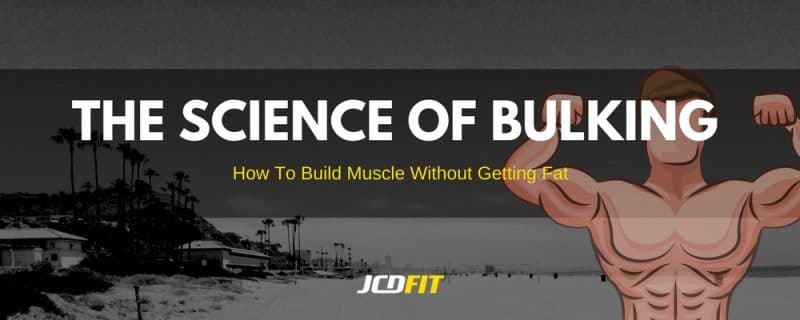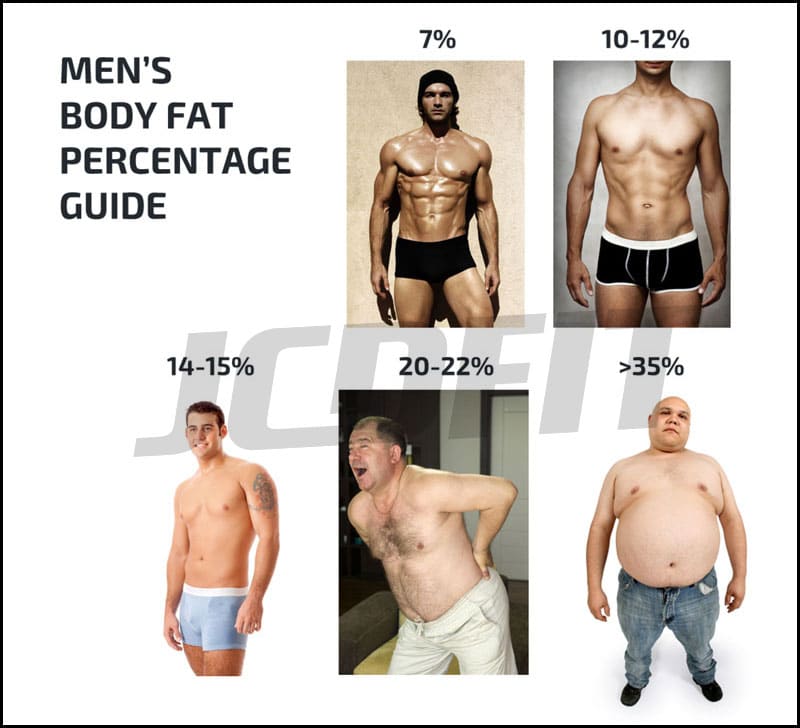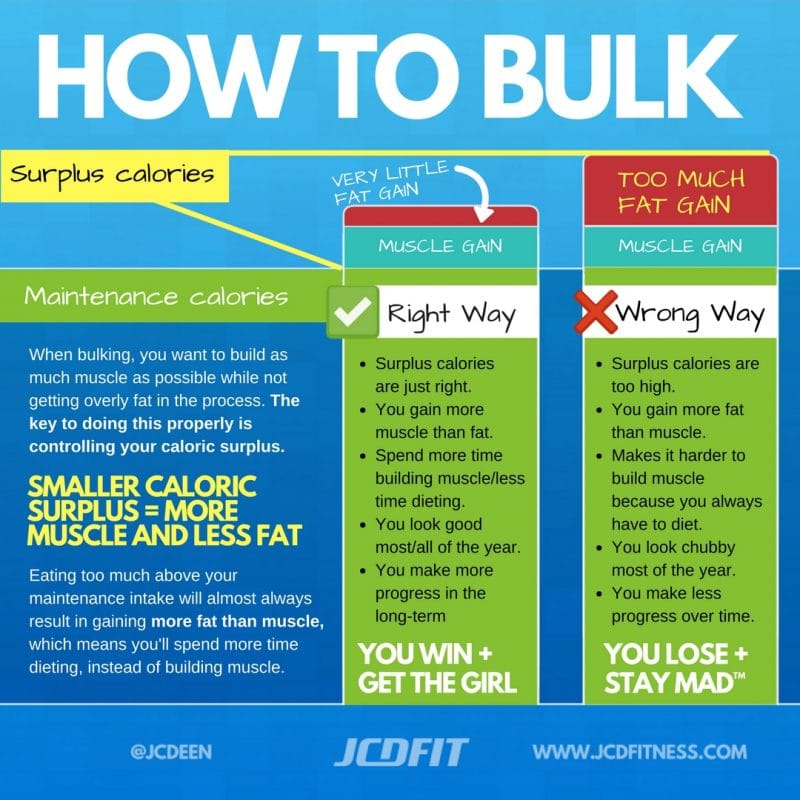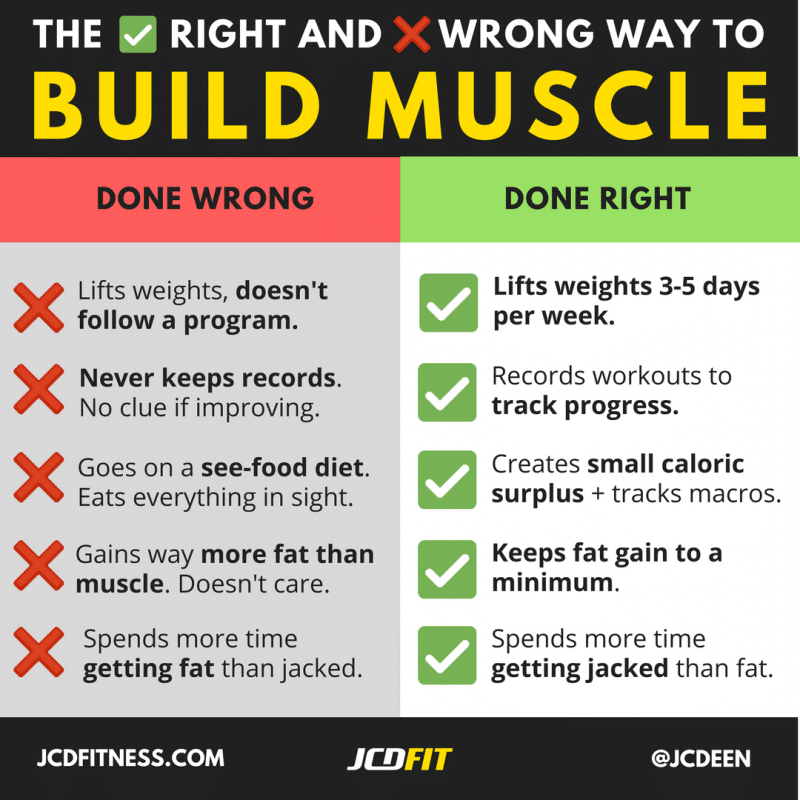Bulking is a term that’s been well known in the bodybuilding circles since they first began decades ago.
And to make it as simple as possible, bulking means to gain weight by intentionally overeating.
In this guide, you’re going to learn everything you need to know about bulking for muscle gain without getting fat.
You have probably heard people say “it’s time to bulk up” and they simply mean they’re gaining weight in the hopes of building muscle.

You’ve probably also heard people say “I’m bulking” right before they inhale an entire pizza.
In fact, many people have dedicated entire periods of time to deliberately gaining body weight and we call this bulking season.
In general, the entire point of bulking is purely to add more muscle to your body to enhance your aesthetic appeal.
If you want bigger shoulders, arms, chest, legs, or back muscles, you’ve got to eat above and beyond your body’s caloric needs.
Eating more than you burn means you’re eating a surplus of calories.
But you can’t just eat a bunch of food and wake up 3 months later looking like Hercules.
You must also be training hard in the gym or using bodyweight training to make sure most of the weight you gain is muscle, not fat.
The Difference Between Bulking And Cutting
The terms you might (or not) be familiar with are bulking and cutting, which have been used by bodybuilders to explain what phase of their training they’re in.
Bulking phase = a period of time where one eats more food to get bigger and stronger. This is typically the winter months, also known as bulking season. They call it bulking season because they’re typically spending multiple months in a caloric surplus to gain weight.
And since bulking season is usually done during the colder time periods, people are often wearing more clothing, such as long pants and sweaters so as to cover up their so-called ‘winter fluff.’
Cutting phase = a period of time where one eats less food to get leaner. This is typically the spring months leading up to summertime.
Since bulking can go incredibly well or terribly wrong, you should know a thing or two about how this process works. The types of foods + how much food you eat matters. Let’s get into it.
How The Body Builds More Muscle
This process is incredibly complex from a physiological perspective, but here’s what you need to know.
Your body makes new muscle through a feedback loop known as the signal and the response.

This process is known as muscle hypertrophy. Keep in mind, you can get as nerdy as you want to learn about how muscle grows from resistance training but you’re here to get jacked, not spend all day in a lab studying this stuff, right?
The Signal [Resistance Training]
When you lift weights intensely, you break your muscles down and they must go through a recovery phase.
As a result, you have to allow your muscles to recover before you can perform another training session with a similar intensity.
Intense weight training is the signal that tells your body it needs to repair itself and come back stronger.
But training must be intense, challenging, and should be focused on making progress in some manner. Either you’re adding weight and/or doing more reps or sets regularly.
If you’re not consistently giving your body an intense stimulus (signal), the body won’t adapt and grow. Training with heavy weights causes this process to happen via three pathways:
- Mechanical Tension: Heavy strength training (heavy is relative to what is challenging for you, typically taking a movement to near muscular failure). This is similar to the training of Olympic lifters and powerlifters—they train specifically for moving heavy loads. Any resistance against the muscle over a period of time is going to create tension.
- Metabolic Stress: Typically achieved through mid- and high-rep training which induce fatigue and shortness of breath. It also causes the burning sensation, as you deplete oxygen in the muscles. You know how your muscles swell up after high-rep sets? That’s what we’re going for here. This feeling is also known as the pump to most gym rats.
- Muscle Damage: Muscle soreness days after your training is usually indicative of the muscle damage, also known as delayed onset muscle soreness (DOMS). This is the results of micro-tears in the muscle tissue (a good thing, mind you). This mostly comes from the eccentric portion of a movement (lowering of the weight on a leg extension or bicep curl), so try to keep your eccentrics slow and controlled during your high-rep sets.
So while the process of creating a proper signal for muscle growth is complex in how it actually happens, it’s really as simple as the following:
- lifting heavy weights
- following a proper program
- pushing yourself regularly during your workouts
The Response [Protein Synthesis]
After you’ve gone through the hard training, your body will repair itself using the food you eat, protein being the key macronutrient.
Since your muscles have undergone some damage from weight training, your body places extra emphasis on rebuilding and repairing the muscles.
Muscle protein synthesis is happening all the time, but it’s especially elevated after hard training.
The following are some quotes straight from the science to help you understand how this process works (source):
Muscle protein synthesis will remain above basal levels for up to 48 hours after resistance training, so consumption of protein/amino acids during this time may also aid in building muscle compared to times when exercise was not performed.
Since you’re likely training 3-4 days per week, this means for 2 days after your workouts, your body is actively repairing the muscle damage that occurred during training.
This is why eating more than the standard RDA (recommended daily allowance) is crucial for helping your muscles repair and grow from your hard workouts.
For bulking, I recommend .8-1 gram per pound of body weight. In my how much protein do I need article, I lay the foundation for getting enough protein and how to do it. But if you want to, you can definitely eat more protein (to the tune of 1.5 grams per pound of lean body weight) which can improve recovery rates for those who are very active.
Essential amino acids, especially leucine, are most effective at stimulating muscle protein synthesis.
If eating more protein is new to you, check out my article on how to eat more protein.
Most animal protein sources are good choices because they contain all of the 9 essential amino acids. The amino acid leucine plays a major role in muscle protein synthesis.
Consuming foods such as beef, dairy, seafood, fish, and chicken are all good sources of leucine. So chances are, if you’re getting enough protein and training hard, bulking will be a fruitful endeavor.
If you prefer a vegan or vegetarian diet, we have good news. Pea protein contains all the 9 essential amino acids and a good dose of leucine, so may the gains be with you bro!
Since I don’t consume much dairy these days, I have replaced my regular intake of whey with pea protein powder.
So I still get the same benefits, and a similar amino acid profile while experiencing none of the negatives from regular dairy consumption (bloating, gas, etc).
I personally use and recommend NOW brand pea protein.
What To Know About Weight Gain
Bulking is the act of gaining weight on purpose in the name of adding more muscle to your body. If you have former fat boy issues and are afraid of gaining weight, I hear you.
NO ONE WANTS TO GET FAT AND OUT OF SHAPE.
But if you’re afraid of gaining weight, you aren’t going to gain much muscle.
All your hard work and effort will seem to be in vain at the end of your bulking phase and you’ll only feel like a massive failure.
Building muscle while attempting to bulk up can go wrong in many ways. We’ll cover those, but first, let’s go over what’s essential.
There are Three Main Rules you want to adhere to so you gain more muscle than fat on your bulk:
- Be relatively lean when starting your bulk
- Avoid gaining weight rapidly
- Track your intake
Start Your Bulk From A Relatively Lean State
For the most part, you want to be fairly lean when you start your bulk. There are multiple reasons for this, but the first one is and should be very obvious.
You Are Going To Gain Some Fat During Your Bulking Phase.
This is normal and you should accept this fact right now.
Inhale, Exhale.
Realize that yes… you will gain some fat as it’s just a part of the process.
The good news is you can always lose it later. Losing fat is easy. Building muscle is much harder in comparison.
–
How Lean Should You Be To Start A Bulk?
Ideally, you want to be somewhere between 10 and 15% body fat. You can be leaner, but it’s not necessary to get started.
For reference, see the images below.

If you’re a man above 15% body fat, you will want to focus on losing body fat first. If you start a bulk above 15% body fat, you will just gain unnecessary fat while building muscle and it will take longer to lose that fat once you’re done bulking up.
For women: see my muscle building guide for women.
Why You Should Avoid Rapid Weight Gain When Bulking
Getting fat sucks.
It sucks real bad.
Having to lose a bunch of fat you unnecessarily put on because you couldn’t control your food consumption during bulking season is no fun for anyone.
It will suck for you because it will take longer to get into great shape.
It will be annoying for those around you because they’ll have to constantly hear about you being on a diet. (sort of joking)
But here’s the deal.
It’s easy to fall into the horrible trap of stuffing your face in the name of gainz.
Carelessly eating a ton of food in the hopes of swelling up like your favorite bodybuilder will only make you much fatter than necessary.
A caloric surplus is NECESSARY to gain muscle. You know this.
But MORE IS NOT BETTER.
Repeat that in your head over and over again.
More food, in this case, will equate to more fat, not more muscle.
I made a quick graphic to help you understand why a huge surplus will always equate to getting fatter faster.

As you see above, a surplus beyond a certain point will only add more fat than muscle. Would you rather gain weight slowly and build as much muscle as possible, or gain weight rapidly cutting your muscle gain phase prematurely short?
Track Your Intake To Ensure You Gain Mostly Muscle
Ahh yes, tracking your macros and calories.
If you skip this step, you’ll most likely fall under one of two outcomes:
- You’ll eat way too much and get fatter than you’d like.
- You’ll habitually undereat for fear of fat gain and not make any gains.
Yes, there is the small percentage of people who can get by without tracking their intake, lift every week, grow like a weed and not gain any body fat.
But they’re rare. Don’t use their results as the standard.
If you know NOTHING about tracking your intake, start with what are macros. If you are familiar with macros and calories, check out this full guide: how to count macros.
Tracking your intake will allow you to make sure you eat just enough to cause muscle growth without getting overly fat in the process.
Why Getting Too Fat Is A Massive Problem
If you take the approach of eating everything in sight (also know as dirty bulking), you’ll likely regret it.
This is because you will gain lots of fat too quickly, which results in a handful of issues:
1. More Fat Gain = Lower Insulin Sensitivity
The fatter we get, the lower our sensitivity to insulin. This is a fairly complicated topic, but here’s what you need to know.
Insulin is needed in order to transport nutrients from the food we eat into our cells. If our insulin does not increase regularly after meals, we won’t get the necessary nutrients and we die. Simple as that.
And since insulin is THE hormone that shuttles the broken down food for energy into our cells, we want it to be working properly and optimally. The fatter we get, the less sensitive our bodies are to the hormone.
Conversely, the leaner we are, the more sensitive to insulin we’ll be. The more sensitive to insulin we are means we have a greater ability to build muscle and burn fat.
The good news is simply being active and weight training alone will boost your insulin sensitivity.
2. Higher Body Fat Might Affect Muscle Protein Synthesis
A high level of body fat (anything above 20% for men), along with poor insulin sensitivity seems to cause muscle breakdown. So if you have a high amount of body fat currently, your focus should be on losing the fat first before you even think about bulking up.
However, while you’re in the process of leaning out, you should still be weight training 3-4 days per week because this will help you build muscle and it will increase your insulin sensitivity.
3. Higher Levels Of Body Fat Correlate With Higher Levels Of Estrogen
High estrogen levels are a death sentence for maximal muscle gain and a lean, muscular body.
Total and free testosterone and sex hormone binding globulin concentrations decreased, whereas total and free estradiol (estrogen) increased with increasing BMI, waist circumference, and percent body fat. (source)
Testosterone and Estrogen have an inverse relationship meaning while estrogen is high, testosterone will be low. When testosterone is high, estrogen levels will typically be low. These are incredibly simple statements, but for the most part, we want estrogen levels to be on the lower side to ensure our hormonal system is at its best to build muscle.
One of the best ways to ensure estrogen levels are low is to be relatively lean. Plus, high testosterone is crucial for maximal muscle gain and protein synthesis.
4. The Fatter You Get, The Longer You Have To Diet
It’s a negative spiral. If you get fatter and fatter, you will have to diet longer. The longer you diet, the less time you have to be building muscle.
The less time you spend building muscle, the harder this process will be.
Why A Caloric Surplus Is Necessary
Every single day your body uses energy to move, talk, read, think, and exercise.
The food you eat goes toward replacing the energy you expend during those activities.
As a result, if you’re wanting to bulk up and build muscle, you have to create an excess of available energy by eating more calories.
Without the extra calories, you won’t be able to build and create new muscle mass.
How To Determine Your Caloric Surplus
A caloric surplus is eating more than you are burning on a daily basis. Weight gain is mostly easy math. If you burn 2000 calories per day and you eat 2500 calories, you’ll gain weight. If you eat less than 2000 calories, then you’ll lose weight.
Eat 2000 calories per day? You guessed it… you’ll maintain your weight.
First of all, you must know your individual maintenance calories. You can determine that by using my calorie intake calculator.
Ideally, you’ll want to consume anywhere from 200-400 calories above maintenance per day to ensure you’re in a caloric surplus. But in fact, the more advanced you are, the smaller the total surplus of calories you need.
I cover that in my ideal caloric surplus article.
How To Build Muscle And Lose Fat At The Same Time
While it’s possible to build muscle and lose fat at the same time, it doesn’t happen for everyone. Most people who experience this are typically beginners who haven’t worked out in the past or people who’ve exercised before but have taken some time off.
In other words, if you’re not brand new to weight training and dieting for fat loss, THIS IS A HUGE TRAP to fall into.
Building muscle for the beginner is incredibly easy compared to the experienced lifter.
And many times, a beginner can be on a fat loss diet and still build muscle because of how easy their body will build muscle from the weight training signal alone.
But for everyone else who has at least one year of training experience, trying to lose fat and build muscle at the same time is a huge waste of time that will leave you with very little muscle gained and hardly any noticeable fat loss.
Why Chasing Fat Loss And Muscle Gain At The Same Time Is A Trap
I know how enticing it is to want to pursue both goals at the same time. I’ve been there.
But nothing is more frustrating than looking back at your workout logs and weight loss measurements in frustration.
Frustration from making hardly any progress in either direction.
So it’s best to establish the goal that is most important to you.
Do you value having more muscle than you currently have?
Are you a man under 15% body fat (25% for women)?
Good—then it’s probably the best choice to focus on building muscle.
But if you value losing fat more than building muscle, you should focus on that goal first.
Weight Training Is Optimal To Build Muscle When Bulking
Weight training workout plans are ideal if you want more muscle for the following reasons:
- You can easily overload every muscle group with barbells, dumbbells, and machines.
- You can chart your progress by logging your workouts each time you train with the goal of improving your lifts every week.
- You can follow a very specific plan, so you know exactly what to do every time you hit the gym.
Body weight workouts are fantastic, as well. I’m a fan of GMB’s programs.
But because of the nature of body weight training, it can be hard to progress if you don’t have much experience. And frankly, I feel like working out with weights are ideal because of how quickly you can overload the body.
For beginners, see my beginner muscle building routine.
If you’re more advanced and need more volume, I suggest using an upper/lower routine.
If you’re a woman and want to focus on muscle gain, you can check out my muscle building guide for women. Also, take a look at my weight training for women guide.
Interested in building your glutes? Check out my Booty Workout or my Big Butt Workout plan.
Weight Gain And Expectations
Think about your results on a spectrum. On the left, you’ll see the ability to gain muscle is way easier the less experienced you are. The more experience (and the more muscle) you gain, the slower your rate of muscle gain becomes.
As a result, you should use the following advice as a basis for setting yourself up with realistic expectations.

The following is taken from my caloric surplus article.
These images were created based on Lyle McDonald’s model of the genetic limits for maximum muscular potential. There are various models but they’re all very similar in the conclusions for the maximum amount of muscle one can gain.
Since there’s a genetic limit to how much muscle we can gain, we need to be realistic with our rates of progress. Casey Butt has an interesting calculator you can check out here. Just plug in your current stats he asks for and you’ll get a nice prediction for how big you can be given your genetics.
The only way to go above and beyond the genetic ceiling for muscle gain is to take androgenic anabolic steroids. I’ve never taken steroids, so I cannot give recommendations on this… just know that when you take these drugs, you expand your genetic limits.
Also, this is why it’s so discouraging when you’re flipping through Instagram and you see these massive, lean bodies of individuals who make the claim they’re lifetime natural trainees when in reality, they’re not.
How Much Weight Should You Ideally Gain?
There are two lines of thought here:
- Gain weight quickly and worry about dieting it off later.
- Gain weight slowly and make sure you don’t get fat in the process.
We know so far that gaining lots of weight quickly will only result in excessive fat gain, so we can scratch that off our list of things to do.
Since you want to gain weight slowly, here’s a good idea of how much weight gain to aim for each week:
- Beginners (less than 2 years training experience): 4 pound per month
- Intermediates (2-4 years training experience): 2 pounds per month
- Advanced trainees (4+ years training experience): 1 pound per month
For the most part, the ratio of muscle to fat gain will be more ideal the slower you gain weight, but for beginners, the ratio is much favorable due to how much muscle you can gain in your first year of proper training.
That’s why it’s possible to gain 20+ pounds of muscle in your first year as a beginner.
Keep this in mind: if you’re a beginner or intermediate, if you’re not gaining a modest amount of weight during your bulking phase, you’re likely not going to be adding much muscle. Muscle building takes energy (from food) to synthesize the new muscle tissue. So it’s important that you give your body what it needs to grow.
Some fat gain is inevitable, but you can diet off the excess relatively easily.
The Top 5 Mistakes People Make When Bulking

1. Lifting weights but not following a program. This is a massive mistake because anyone can go to the gym and ‘work out’ but following a structured program is best.
2. Not logging progress or keeping good records. Your goal should be to improve your lifting progress over time. If you’re not getting stronger, overloading your muscles, and pushing yourself, you’ll look back in 6 months wishing you’d been more disciplined.
3. Going on a ‘see-food’ diet. If you think you can eat everything in sight and gain nothing but muscle mass, you’re in for a rude awakening. Fat is easy to gain. Muscle is not. Best to control your intake, track macros, get enough protein and let the body do what it does best.
4. Gains more fat than muscle. This is often a mistake many beginners make. They overestimate how much muscle they can gain and gain way more fat by making mistakes 1-3.
5. You spend more time getting fat and have to go back to dieting sooner than necessary. Which ultimately means you cut your muscle gain efforts short.
Clean Bulk Versus Dirty Bulking
(article coming soon on clean bulking vs. dirty bulking)
How To Set Up A Proper Bulking Program In 3 Steps
Step #1: decide how many days you can train and pick a program. My beginner workout routine or any of these workout plans will work for you.
Step #2: determine your ideal caloric surplus by using my simple calorie intake calculator. Just input your info into the calcualtor and select the ‘muscle gain’ option to determine how much food you need.
